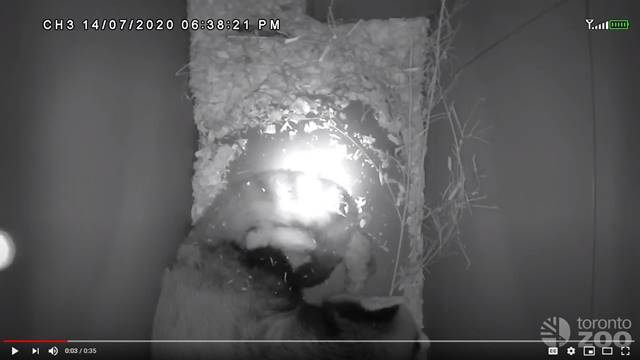
CUTE ALERT! TORONTO ZOO WELCOMES BIRTH OF ENDANGERED RED PANDA CUBS
FIRST RED PANDA CUBS BORN AT YOUR TORONTO ZOO IN 24 YEARS

To catch a glimpse of #BabyReds in their nest box,

TORONTO, ON, Friday, July 17, 2020: In the late afternoon of Tuesday, July 14, 2020, Ila, your Toronto Zoo’s two-year-old female red panda (Ailurus fulgens refulgens), gave birth to two healthy cubs. This is the first red panda pregnancy at the Zoo since 1996, and this is the first offspring for mother Ila with father Suva, a three-year-old male. Ila, from Woodland Park Zoo, and her mate Suva, from Assiniboine Park Zoo, are both relatively new Toronto Zoo residents, and were paired up at the recommendation of the Association of Zoos and Aquariums (AZA) Red Panda Species Survival Plan (SSP), a cooperative breeding program among accredited zoos. Both mom and cubs are doing well and Wildlife Care Keepers continue to monitor Ila and cubs closely, using cameras for minimal disturbance, to ensure cubs continue to nurse from Ila regularly. While the first few weeks are critical to the cubs’ survival, we are cautiously optimistic based on the activity we are observing on the cameras.
Toronto Zoo announced Ila’s pregnancy on Friday, June 19, 2020 – which was also her 2nd birthday. Red panda breeding season takes place from January to April. It takes less than three months for the cubs to develop in the womb, although the embryos may not implant in the uterus and begin growing immediately after fertilization (called “delayed implantation”). This makes predicting a due date challenging, since the pause in development can last for several months. Keepers observed several breeding attempts between Ila and Suva on March 4, 2020.
To monitor her reproductive cycle, Ila's feces have been continuously collected for hormone analysis by our Reproductive Sciences department. However, a rise in pregnancy hormones does not necessarily indicate pregnancy: in addition to delayed implantation, red pandas can also experience pseudo pregnancy, when the body goes through all the physiological and hormonal aspects of pregnancy, including an enlarged fluid filled uterus, but without any babies. The only way to confirm pregnancy is to see the growing babies on ultrasound. Ila has been trained to participate in voluntary ultrasound sessions, and our veterinary team observed two well defined fetuses via ultrasound on Tuesday, June 16, 2020, including heartbeats from both. Red pandas can have one to four cubs at a time, but they typically give birth to two.
“With this being the first red panda born at your Toronto Zoo in 24 years, needless to say we are excited to be contributing to the population of this endangered species,” says Dolf DeJong, CEO, Toronto Zoo. “This is a great example of the critical work done at the Toronto Zoo with our world class wildlife care team,” he added.
In April 2015, the conservation status of red pandas was elevated to Endangered by the International Union for Conservation and Nature (IUCN). Red pandas are elusive and challenging to study in the wild – their population has been estimated by experts as anywhere between 2,500 and 10,000 individuals, but all agree that the species is declining – by as much as 50% in the past 20 years. Illegal hunting and habitat loss are their primary threats. The Toronto Zoo is part of the AZA Red Panda Species Survival Plan (SSP) and continues to support field conservation efforts for the species through the Red Panda Network. To find out how you can support the endangered red pandas and other wildlife conservation work at your Toronto Zoo, please CLICK HERE.
Follow us on social media for updates on #BabyReds!
-30-
Note to media: Zoo staff are focused on the health and well-being of Ila and her cubs and we will share updates as available. Media/photo opportunities are not available at this time.
Media Contact Information:
Katie Gray
Manager of Strategic Communications
(416) 938-5283
[email protected]
Amanda Chambers
Supervisor of Strategic Communications
[email protected]